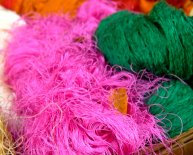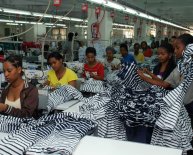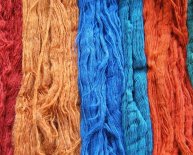
Modern textile industry
 Though cozy flannels, tasteful tartans, and cotton prints depicting George Washington and Ben Franklin in political discourse have undeniablecharm, textile design realized a fuller exuberance around the time that Charles Eames famously instructed designers and consumers alike to "take your pleasure seriously." The Eameses did just that in connecting the dots of both formal play and industrial might in patterns both random and precise. Contemporary Alexander Girard’s textiles boast brilliantly colored prints and woven geometrics, and Verner Panton’s optical extravaganzas surely justify his own dictum: "Beautiful can be ugly. Ugly can be beautiful."
Though cozy flannels, tasteful tartans, and cotton prints depicting George Washington and Ben Franklin in political discourse have undeniablecharm, textile design realized a fuller exuberance around the time that Charles Eames famously instructed designers and consumers alike to "take your pleasure seriously." The Eameses did just that in connecting the dots of both formal play and industrial might in patterns both random and precise. Contemporary Alexander Girard’s textiles boast brilliantly colored prints and woven geometrics, and Verner Panton’s optical extravaganzas surely justify his own dictum: "Beautiful can be ugly. Ugly can be beautiful."
Not that modern textiles were about pleasure entirely. With all its new energy and optimism, postwar design put a high value on fabrics that were architectural, inexpensive, and colorful without being decorative in a sentimental manner. So just as bright printed fabrics from modernist hotbeds Sweden and Finland held sway, so too did the engineering and science of the war years, which would be redirected to design and consumer goods.
As America’s postwar boom embraced European modernism, designers like Florence Knoll married elegant geometrics with machine-made fabrics. At the more austere end of the spectrum was weaver Anni Albers, who took a more sculptural approach in
her abstract, multidimensional textiles and who was certain that "the less we, as designers, exhibit in our work our personal traits…and idiosyncrasies—–in short, our individuality—–the more balanced the form we arrive at will be. It is better that the material speaks than that we speak."
Perhaps the most vital innovation in modern textile design came not in content or form but in use. Fabric was embraced to help give shape to open-plan living, gird the expansive plate-glass windows that were suddenly ubiquitous, and add warmth to new halls of concrete and stone.
Though we’ve now wandered through the 1970s (" the beige decade, " as it was called by textile designer Jack Lenor Larsen), when natural hues all too often resulted in a monotonous drabness, contemporary designers take their pleasures as seriously as their mid-century predecessors while reflecting some of the same visual perspectives. Artist Maira Kalman’s "Story of My Life" pattern is a spirited rebuke to Albers’s dictum regarding the dangers of one’s peculiarities and idiosyncrasies; it is an impressionistic catalog of pen-and-ink pictographs of ladders, birds’ nests, dancers, and wedding cakes.
Illustrative whimsy aside, contemporary textiles continue to take their cues from the annals of industry. Marcel Wanders worked with the Aerospace Engineering Laboratory at Delft University of Technology on the carbon-aramid netting for his Knotted chair, while yarns using photoluminescent pigments are finding their way into textiles for interiors. Lest one be tempted to think the story is all about such techno-synthetics, we have also seen the rise of small-batch fabrics and a return to craft. Contemporary textiles made of natural materials, such as bamboo, linen, and alpaca, highlight innovative construction and a lavish surface touch. The innate beauty of the yarns is the message here. Albers would have approved.
















